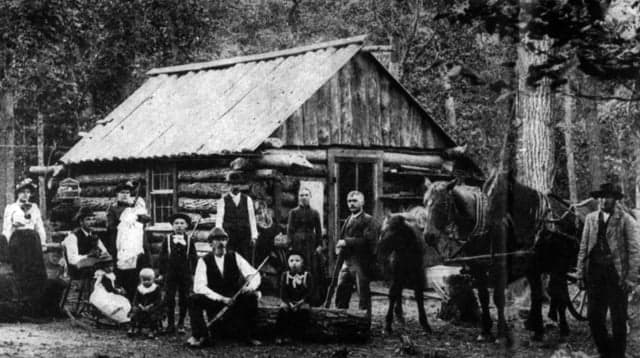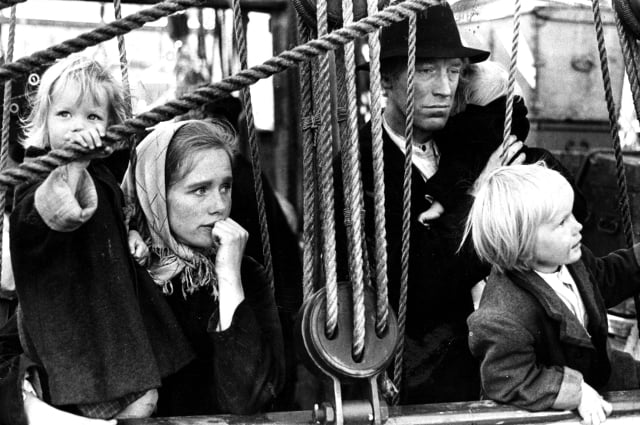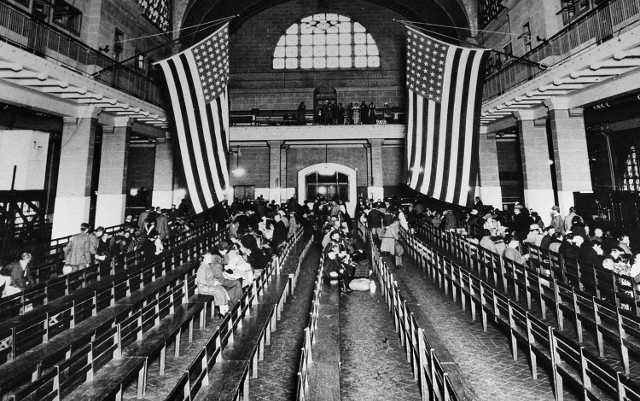The migration crisis that divided Sweden and made it a better country

More than a million Swedes emigrated to North America between 1830 and 1930, fleeing poverty, religious persecution and lack of political freedom. But the crisis also brought new ideas to the Nordic country and forced it to find a new way forward.
This article is available to Members of The Local. Read more articles for Members here.
In the second half of the nineteenth century, a mass migration crisis divided Sweden and even, some thought, threatened its very existence.
Swedish journalist Isidor Kjellberg wrote in 1883 that if everybody who wanted to emigrate could, "probably the Swedish kingdom and Swedish people would cease to exist".
Just four years later, peak emigration was reached when nearly 51,000 Swedes – around one percent of the country's population – sought new lives elsewhere. This record was only broken over a century later in 2011 when the population was more than double what it had been in 1887.
What had started as a slow trickle of emigrants from Sweden in the 1830s had become a flood by the 1880s. By 1930, some 1.3 million Swedes had emigrated, with most settling in North America.
Although Swedish emigrants accounted for only around two percent of the approximately 60 million people who left Europe between 1815 and 1932, the impact on Sweden was profound, both numerically and sociopolitically. Between 1830 and 1930, the country lost around 20 percent of its population to emigration.
The key drivers of this exodus – including poverty and famine, overpopulation, religious persecution, and lack of political freedom – pitted liberals and conservatives at all levels of society against one another. In the midst of this crisis, Sweden's future as a social democracy began to take root.
Beyond the obvious attractions of the legacy of Swedish-American culture and genealogical connections between Sweden and North America, the story of Sweden's great emigration reveals how the country started on its path to becoming one of the world's best countries.

Liv Ullman and Max von Sydow in the movie 'The Emigrants' about Swedes moving to the US in the 1800s. Photo: Skånereportage
From Colonialism to Mass Exodus
According to Statistics Sweden (SCB), of the 1,170,456 people who left Sweden between 1851 and 1910, 948,823 went to the United States. But prior to the great migration, Swedish presence in North America had been small, especially compared to the Dutch, British, French and Spanish.
In 1638, Sweden joined in the colonization of North America by establishing New Sweden in the Delaware Bay. Around 600 people from Sweden and Finland settled in the colony, which eventually encompassed parts of present-day Delaware, Pennsylvania, New Jersey and Maryland. By comparison, New Netherlands had a population of around 2,000 to 3,500 when, in 1655, New Sweden was surrendered to the Dutch.
The former Swedish colony became a part of New Netherlands, but was allowed to continue in varying degrees of semi-autonomy – first under the Dutch, followed by the British – until 1681. Even as the former lands of New Sweden were fully absorbed into British Crown colonies, the descendants of its original settlers retained a decidedly Swedish identity.
In Swedesboro, New Jersey, for instance, a Swedish Lutheran parish was established in 1703, and a church was built where clergy from Sweden conducted services in Swedish. It wasn't until after a new church was dedicated in 1786 that the congregation stopped importing Swedish clergy and conducting services in Swedish. Today, the church exists as Trinity Episcopal Church, though it is fondly called Old Swedes' Church.
.jpg)
Swedesboro, New Jersey, in 1912. Photo: Wikimedia Commons
The liberality that permitted such religious and cultural freedom of expression was greatly admired by Swedish intellectuals of the Enlightenment, even though few Swedes actually emigrated to North America just after 1655. The prospect of those freedoms made a lasting impression, however, and interest in emigration to North America, particularly to the United States, was increasing in Sweden by the 1840s.
A few intrepid Swedes had already made the journey, despite the fact that it was tightly restricted by law until 1840. One of these, Svante Magnus Swenson, from Jönköping county, emigrated to the United States in 1836, and made his way to Texas when it was still a Republic. In time, Texas became the 28th state of the United States of America, and Swenson became one of its most prominent citizens and largest landowners.
With legal restrictions on emigration removed after 1840, a growing number of Swedes began to join the wave of European emigration to the United States. In 1841, Gustaf Unonius of Uppsala was among the first to take advantage of the greater freedom of movement. Along with a small group, he immigrated to Wisconsin. Unonius, like Peter Cassel of Kisa in Östergötland, who emigrated to Iowa with 17 others in 1845, proved to be highly influential in encouraging others to emigrate.
While conservatives in Sweden painted emigrants as irresponsible dreamers who abandoned their homeland, and characterized North America as a wild and lawless land that lacked religion and morality, Swedish enclaves like Cassel's grew. One year after Cassel died in 1857, New Sweden, Iowa, had 500 residents.
Svante Swenson was also an important influencer on Swedes back home. Starting in 1847, he began actively encouraging his countrymen wishing to emigrate to settle in Texas. Together with his uncle, Svante Palm, they created an immigration channel known as "the Swedish pipeline". Although Swenson died in Brooklyn in 1896, more than 4,300 of his fellow Swedes were reported living in Texas in the 1900 census.
Some of the earliest Swedish emigrants to North America were religious separatists like Eric Jansson of Uppland. Lutheranism had been the state religion in Sweden since 1593, and adherence to orthodoxy of the state church was strictly enforced. Dissenters could be punished with imprisonment or exile.
By the mid-1800s, an increasing number of Swedes were pushing back against the church, with some going as far as breaking off into illegal religious sects like Jansson's. In 1846, he and as many as 1,500 followers left Sweden for the United States. The much smaller group that survived the journey created a communal religious colony in Illinois called Bishop Hill that existed until 1861.
Toward a Social Democracy
Between 1820 and 1850, it is estimated that total emigration from Sweden had only been around 5,000. During the decade of the 1850s, it leapt to approximately 15,000. After the American Civil War ended in 1865, the numbers began to skyrocket as increasing numbers of Swedes were impacted by disease and famine. The situation had become so serious that in 1900, Chicago counted more Swedish-born citizens than Gothenburg, Sweden's second most-populated city.
But despite the very serious social, political, religious and economic causes driving Swedish emigration, the early discussion and debate on the subject focused more on the character of the emigrants than on the actual issues. While some in Sweden accused them of being unpatriotic, greedy, lazy and immoral, others defended them as the backbone of the New World.
"…it is this 'rabble' from Europe which has made America great, and it is its sons who today form the bone and marrow of the nation. America shows the emigrant's worth," wrote Olof Bergström in 1882.

Immigrants in the registry room at Ellis Island in New York in 1924. Photo: AP
There also existed an ideological divide between liberals and conservatives that centered on issues like religion, social structure, duty and tradition.
The late Swedish-American historian H. Arnold Barton wrote in his 1994 book, A Folk Divided: Homeland Swedes and Swedish Americans, 1840-1940, "…conservatives sought to conserve a traditional social order based on hierarchy, authority, and respect," and believed that, "the national interest must take precedence over those of its individual subjects".
Liberals, on the other hand, believed, he wrote, "…that the state existed to uphold and protect the rights and welfare of its citizens (not subjects), and that if unable to do so it should not hinder them from seeking their legitimate self-interests elsewhere".
Eventually, both liberals and conservatives found common ground in their recognition that the country's future depended on addressing the root causes of the emigration and making Sweden at least as attractive to its citizens as the United States had become.
According to H. Arnold Barton, "Swedish thought regarding America, emigration, and the emigrants provided the basis for much painful reappraisal of Swedish society itself, reinforced by the criticisms, both implicit and explicit, of those who had sought new homes in the New World".
By the 1880s, an increasing number of political and social reforms were being introduced that began the gradual process of transforming Sweden from the country it had been since the seventeenth century into the modern and progressive social democracy it is today. By the 1920s, when conditions on both sides of the Atlantic had changed dramatically and the period of European migration was nearing its end, emigration from Sweden had not only slowed significantly, but an increasing number of Swedes were actually returning to live in their homeland.
Today, Sweden's great migration to North America tends to be perceived with an abstract romanticism that focuses on the cultural legacy that bridges Sweden and the United States. On both sides of the Atlantic, this legacy can be found in literature and cultural heritage.

Statues in Ljuder, Sweden, representing the fictional emigrants who left Sweden in Vilhelm Moberg's novels. Photo: Victoria Martínez
In the United States, for instance, evidence of Swedish cultural heritage and language are still evident. In Sweden, the four novels of The Emigrants Series written by Vilhelm Moberg between 1949 and 1959, and adapted into two films in the 1970s, are considered among the most important works of Swedish literature. In central Småland, where both Moberg and the characters from his novels were from, the Emigrant Trail offers hikers and cyclists the opportunity to follow in the footsteps of real and fictional Swedish emigrants, while the Utvandrarnas hus (House of Emigrants) in Växjö is a museum and research centre dedicated to the history of Swedish emigration.
A closer look at this legacy is not only valuable for what it reveals about both historical and modern-day Sweden, but also for providing perspective and insight into modern migration movements around the world.
Victoria Martínez is an American historical researcher, writer and author of three historical non-fiction books. She lives in Småland county, Sweden, with her Spanish husband and their two children.
Read more from her family and history column on The Local here.
Comments
See Also
This article is available to Members of The Local. Read more articles for Members here.
In the second half of the nineteenth century, a mass migration crisis divided Sweden and even, some thought, threatened its very existence.
Swedish journalist Isidor Kjellberg wrote in 1883 that if everybody who wanted to emigrate could, "probably the Swedish kingdom and Swedish people would cease to exist".
Just four years later, peak emigration was reached when nearly 51,000 Swedes – around one percent of the country's population – sought new lives elsewhere. This record was only broken over a century later in 2011 when the population was more than double what it had been in 1887.
What had started as a slow trickle of emigrants from Sweden in the 1830s had become a flood by the 1880s. By 1930, some 1.3 million Swedes had emigrated, with most settling in North America.
Although Swedish emigrants accounted for only around two percent of the approximately 60 million people who left Europe between 1815 and 1932, the impact on Sweden was profound, both numerically and sociopolitically. Between 1830 and 1930, the country lost around 20 percent of its population to emigration.
The key drivers of this exodus – including poverty and famine, overpopulation, religious persecution, and lack of political freedom – pitted liberals and conservatives at all levels of society against one another. In the midst of this crisis, Sweden's future as a social democracy began to take root.
Beyond the obvious attractions of the legacy of Swedish-American culture and genealogical connections between Sweden and North America, the story of Sweden's great emigration reveals how the country started on its path to becoming one of the world's best countries.

Liv Ullman and Max von Sydow in the movie 'The Emigrants' about Swedes moving to the US in the 1800s. Photo: Skånereportage
From Colonialism to Mass Exodus
According to Statistics Sweden (SCB), of the 1,170,456 people who left Sweden between 1851 and 1910, 948,823 went to the United States. But prior to the great migration, Swedish presence in North America had been small, especially compared to the Dutch, British, French and Spanish.
In 1638, Sweden joined in the colonization of North America by establishing New Sweden in the Delaware Bay. Around 600 people from Sweden and Finland settled in the colony, which eventually encompassed parts of present-day Delaware, Pennsylvania, New Jersey and Maryland. By comparison, New Netherlands had a population of around 2,000 to 3,500 when, in 1655, New Sweden was surrendered to the Dutch.
The former Swedish colony became a part of New Netherlands, but was allowed to continue in varying degrees of semi-autonomy – first under the Dutch, followed by the British – until 1681. Even as the former lands of New Sweden were fully absorbed into British Crown colonies, the descendants of its original settlers retained a decidedly Swedish identity.
In Swedesboro, New Jersey, for instance, a Swedish Lutheran parish was established in 1703, and a church was built where clergy from Sweden conducted services in Swedish. It wasn't until after a new church was dedicated in 1786 that the congregation stopped importing Swedish clergy and conducting services in Swedish. Today, the church exists as Trinity Episcopal Church, though it is fondly called Old Swedes' Church.
.jpg)
Swedesboro, New Jersey, in 1912. Photo: Wikimedia Commons
The liberality that permitted such religious and cultural freedom of expression was greatly admired by Swedish intellectuals of the Enlightenment, even though few Swedes actually emigrated to North America just after 1655. The prospect of those freedoms made a lasting impression, however, and interest in emigration to North America, particularly to the United States, was increasing in Sweden by the 1840s.
A few intrepid Swedes had already made the journey, despite the fact that it was tightly restricted by law until 1840. One of these, Svante Magnus Swenson, from Jönköping county, emigrated to the United States in 1836, and made his way to Texas when it was still a Republic. In time, Texas became the 28th state of the United States of America, and Swenson became one of its most prominent citizens and largest landowners.
With legal restrictions on emigration removed after 1840, a growing number of Swedes began to join the wave of European emigration to the United States. In 1841, Gustaf Unonius of Uppsala was among the first to take advantage of the greater freedom of movement. Along with a small group, he immigrated to Wisconsin. Unonius, like Peter Cassel of Kisa in Östergötland, who emigrated to Iowa with 17 others in 1845, proved to be highly influential in encouraging others to emigrate.
While conservatives in Sweden painted emigrants as irresponsible dreamers who abandoned their homeland, and characterized North America as a wild and lawless land that lacked religion and morality, Swedish enclaves like Cassel's grew. One year after Cassel died in 1857, New Sweden, Iowa, had 500 residents.
Svante Swenson was also an important influencer on Swedes back home. Starting in 1847, he began actively encouraging his countrymen wishing to emigrate to settle in Texas. Together with his uncle, Svante Palm, they created an immigration channel known as "the Swedish pipeline". Although Swenson died in Brooklyn in 1896, more than 4,300 of his fellow Swedes were reported living in Texas in the 1900 census.
Some of the earliest Swedish emigrants to North America were religious separatists like Eric Jansson of Uppland. Lutheranism had been the state religion in Sweden since 1593, and adherence to orthodoxy of the state church was strictly enforced. Dissenters could be punished with imprisonment or exile.
By the mid-1800s, an increasing number of Swedes were pushing back against the church, with some going as far as breaking off into illegal religious sects like Jansson's. In 1846, he and as many as 1,500 followers left Sweden for the United States. The much smaller group that survived the journey created a communal religious colony in Illinois called Bishop Hill that existed until 1861.
Toward a Social Democracy
Between 1820 and 1850, it is estimated that total emigration from Sweden had only been around 5,000. During the decade of the 1850s, it leapt to approximately 15,000. After the American Civil War ended in 1865, the numbers began to skyrocket as increasing numbers of Swedes were impacted by disease and famine. The situation had become so serious that in 1900, Chicago counted more Swedish-born citizens than Gothenburg, Sweden's second most-populated city.
But despite the very serious social, political, religious and economic causes driving Swedish emigration, the early discussion and debate on the subject focused more on the character of the emigrants than on the actual issues. While some in Sweden accused them of being unpatriotic, greedy, lazy and immoral, others defended them as the backbone of the New World.
"…it is this 'rabble' from Europe which has made America great, and it is its sons who today form the bone and marrow of the nation. America shows the emigrant's worth," wrote Olof Bergström in 1882.

Immigrants in the registry room at Ellis Island in New York in 1924. Photo: AP
There also existed an ideological divide between liberals and conservatives that centered on issues like religion, social structure, duty and tradition.
The late Swedish-American historian H. Arnold Barton wrote in his 1994 book, A Folk Divided: Homeland Swedes and Swedish Americans, 1840-1940, "…conservatives sought to conserve a traditional social order based on hierarchy, authority, and respect," and believed that, "the national interest must take precedence over those of its individual subjects".
Liberals, on the other hand, believed, he wrote, "…that the state existed to uphold and protect the rights and welfare of its citizens (not subjects), and that if unable to do so it should not hinder them from seeking their legitimate self-interests elsewhere".
Eventually, both liberals and conservatives found common ground in their recognition that the country's future depended on addressing the root causes of the emigration and making Sweden at least as attractive to its citizens as the United States had become.
According to H. Arnold Barton, "Swedish thought regarding America, emigration, and the emigrants provided the basis for much painful reappraisal of Swedish society itself, reinforced by the criticisms, both implicit and explicit, of those who had sought new homes in the New World".
By the 1880s, an increasing number of political and social reforms were being introduced that began the gradual process of transforming Sweden from the country it had been since the seventeenth century into the modern and progressive social democracy it is today. By the 1920s, when conditions on both sides of the Atlantic had changed dramatically and the period of European migration was nearing its end, emigration from Sweden had not only slowed significantly, but an increasing number of Swedes were actually returning to live in their homeland.
Today, Sweden's great migration to North America tends to be perceived with an abstract romanticism that focuses on the cultural legacy that bridges Sweden and the United States. On both sides of the Atlantic, this legacy can be found in literature and cultural heritage.

Statues in Ljuder, Sweden, representing the fictional emigrants who left Sweden in Vilhelm Moberg's novels. Photo: Victoria Martínez
In the United States, for instance, evidence of Swedish cultural heritage and language are still evident. In Sweden, the four novels of The Emigrants Series written by Vilhelm Moberg between 1949 and 1959, and adapted into two films in the 1970s, are considered among the most important works of Swedish literature. In central Småland, where both Moberg and the characters from his novels were from, the Emigrant Trail offers hikers and cyclists the opportunity to follow in the footsteps of real and fictional Swedish emigrants, while the Utvandrarnas hus (House of Emigrants) in Växjö is a museum and research centre dedicated to the history of Swedish emigration.
A closer look at this legacy is not only valuable for what it reveals about both historical and modern-day Sweden, but also for providing perspective and insight into modern migration movements around the world.
Victoria Martínez is an American historical researcher, writer and author of three historical non-fiction books. She lives in Småland county, Sweden, with her Spanish husband and their two children.
Read more from her family and history column on The Local here.
Join the conversation in our comments section below. Share your own views and experience and if you have a question or suggestion for our journalists then email us at [email protected].
Please keep comments civil, constructive and on topic – and make sure to read our terms of use before getting involved.
Please log in here to leave a comment.